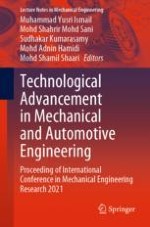2023 | Buch
Technological Advancement in Mechanical and Automotive Engineering
Proceeding of International Conference in Mechanical Engineering Research 2021
herausgegeben von: Muhammad Yusri Ismail, Mohd Shahrir Mohd Sani, Sudhakar Kumarasamy, Mohd Adnin Hamidi, Mohd Shamil Shaari
Verlag: Springer Nature Singapore
Buchreihe : Lecture Notes in Mechanical Engineering
